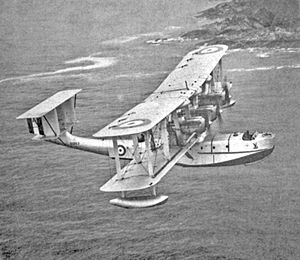Blackburn Iris
| Iris | |
|---|---|
 |
|
| The Blackburn Iris Mk III S1263 | |
| Role | Flying Boat |
| National origin | United Kingdom |
| Manufacturer | Blackburn Aircraft |
| Designer | John Douglas Rennie |
| First flight | 18 June 1926 |
| Introduction | 1929 |
| Retired | 1934 |
| Primary user | Royal Air Force |
| Number built | 5 |
| Variants | Blackburn Perth |
The Blackburn Iris was a British three-engined biplane flying boat of the 1920s. Although only five Irises were built, it was used as a long-range maritime reconnaissance aircraft by the Royal Air Force, where it equipped a squadron for four years, being used to carry out a number of notable long-distance flights. The final version of the Iris, the Iris Mark V was developed into the aircraft that replaced it in Squadron service, the Blackburn Perth.
In 1924, the British Air Ministry issued Specification R.14/24 for a long-range reconnaissance flying boat for the Royal Air Force. To meet this requirement, Blackburn Aircraft proposed the R.B.1 (Reconnaissance Biplane 1), designed by Major John Douglas Rennie, who as Chief Technical Officer worked with John Cyril Porte at the Seaplane Experimental Station, Felixstowe.
The R.B.1 was a three-engined, three-bay biplane. The equal-span wings were of mixed wood-and-metal construction, with ailerons fitted to both upper and lower wings and floats fitted under the wingtips, while the aircraft had a large biplane tail (with a span of 30 ft (9.14 m) with three fins and rudders. The aircraft's hull had a wooden structure covered in plywood, with a V-bottom with two steps to give good water handling. Three 650 hp (485 kW) Rolls-Royce Condor III water-cooled V12 engines driving four-bladed propellers were mounted in individual nacelles between the wings. It carried a crew of five, with two pilots sitting side by side in a cockpit forward of the wings, with nose and dorsal gun positions mounting Lewis guns on Scarff rings, with provision for a further two guns which could be operated through portholes in the rear fuselage. Bomb racks under the wings could carry up to 1,040 lb (470 kg) of bombs.
...
Wikipedia
